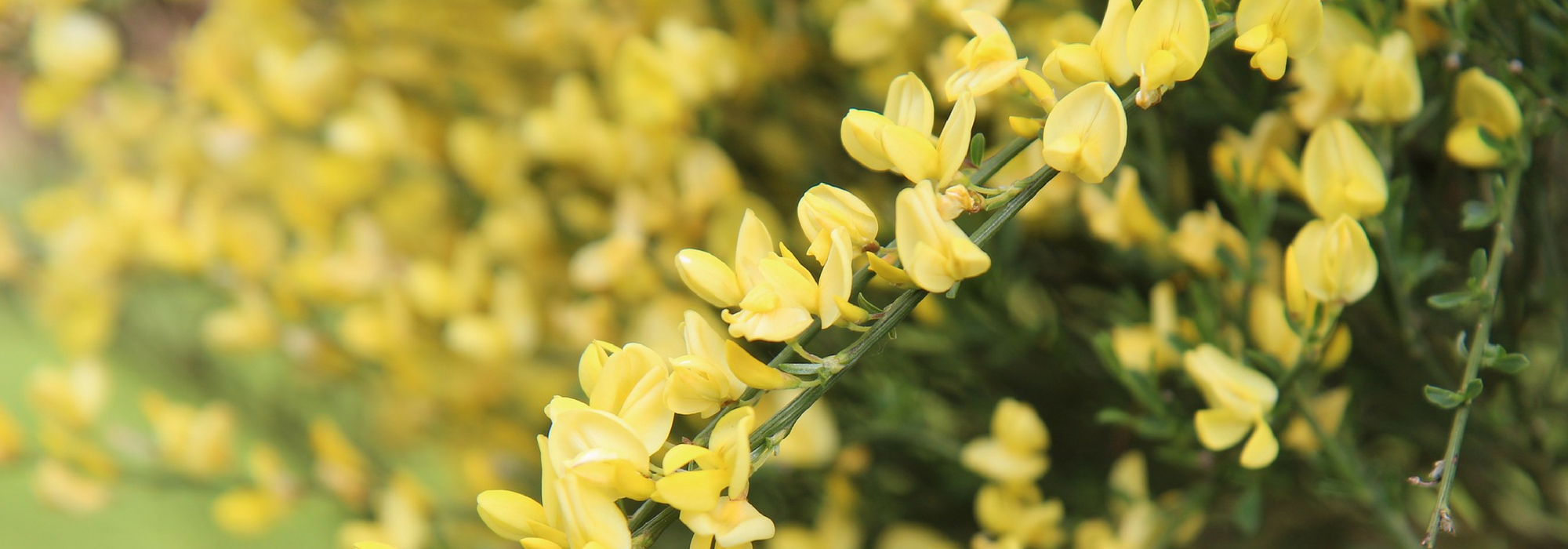
Broom, Cytisus : planting, pruning, maintenance
Contents
Broom in a nutshell
- Small bush that is well ramified, compact and very floriferous, the broom is covered in spring with abundant flowers, most often golden yellow but sometimes purple, red, pink, white or bicoloured
- Its long, flexible and slender branches remain green for almost the entire year
- It loves sunlight, well-drained and poor soils
- Easy to maintain, hardy, well adapted to drought, and low-maintenance, it will find its place in most gardens!
- Creeping or bushy, it is essential in hedges, borders, slopes, and sunny rockeries
A word from our expert
The Broom undoubtedly deserves to be seen and especially smelled in spring or summer. This sun-loving bush is appreciated for its generous flowering, most often golden yellow, which brightens up all wild and natural gardens, sometimes appearing early in spring after the long winter slumber.
This compact and dense bush, creeping or upright, disappears under an avalanche of butterfly-shaped flowers. Today, there are many hybrids such as Cytisus x racemosus and cultivars that offer lovely flowers in warm, varied shades and even sometimes bicolour.
From the red Broom, Cytisus ‘Boskoop Ruby’, to the pink Broom Cytisus ‘Zeelandia’ and the white ‘Albus’ with its bright golden yellow, all have a particularly abundant, incredibly bright, and fragrant flowering.
Alongside the essential Broom and wild Brooms like the Spanish Broom known for their invasive nature, there are rather ground-covering varieties that allow for a wide range of uses in the garden.
Sun-hungry and undemanding, the Broom fears neither poor soils nor cold, and requires only minimal pruning.
Adopt this bush that is robust and low-maintenance, with a silhouette that is both graceful and rustic! The Broom creates beautiful flowering scenes with no maintenance in hedges or borders, in rockeries, on slopes, and in pots for the smaller species!
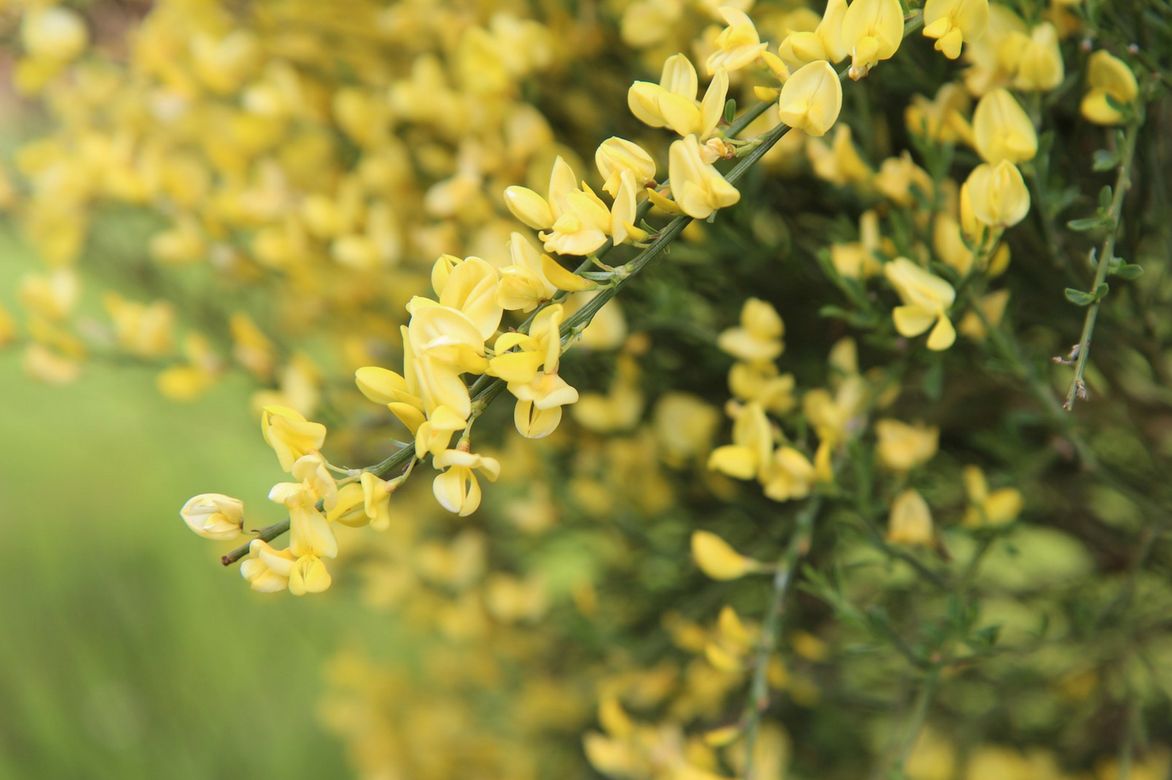
A broom covered in flowers.
Description and Botany
Botanical data
- Latin name Cytisus
- Family Fabaceae
- Common name Broom, Cytisus
- Flowering From March to August
- Height 0.15 to 5 m
- Exposure Sun, partial shade
- Soil type All, well-drained
- Hardiness -15°C to -20°C depending on varieties
The genus Cytisus, closely related to Genista, includes around 50 species of bushes mostly native to the Mediterranean region, the Middle East, and Africa. They can be found from high mountains, in arid and dry places, to low-altitude heathlands where they grow spontaneously. The Broom, sometimes mistakenly called cytisus (which is the common name for Laburnum), belongs to the large family of legumes (Fabaceae).
Among the most popular species is Cytisus scoparius, sometimes referred to as “Broom”, from which the most numerous varieties, cultivars (‘Boskoop Ruby’, ‘Lena’, ‘Andreanus’) and hybrids are derived. The Spanish Broom (Spartium junceum), often confused with rush, is spontaneous and very useful by the seaside: it can become invasive and is considered in the south as one of the garden pests, reseeding and rooting powerfully where it thrives.
Also found is the early broom (Cytisus x praecox), the Purple Broom (Chamaecytisus purpureus) with its purplish-pink flowering, or Cytisus battandieri, known as the Pineapple Broom, with very characteristic flowers shaped like and smelling of pineapple. Genista lydia is the least hardy of the genus. The Dyer’s Broom (Genista tinctoria), common broom, or bastard broom is known for its medicinal and dyeing properties.
Cytisus kewensis, Cytisus decumbens, Cytisus scoparius var prostratus, and Cytisus x racemosus Phebus, a superb improvement of the Tenerife broom, are creeping yellow brooms.

Cytisus scoparius – botanical illustration
Brooms are mainly classified according to their size; they are bushy or ground-covering. This small bush develops a more or less erect, highly branched habit, sometimes very dense, but with a light appearance. It grows in bushy clumps, reaching 4 m high and 2 m wide (but on average rarely more than 2 m) for bushy species. The brooms with a prostrate, creeping, and spreading habit like Genista lydia form dense small cushions of vegetation that are slightly spreading, not exceeding 20 to 70 cm in height for a span of about 1 m after many years.
The growth of the Broom is normal to fairly slow, and its lifespan is short, lasting 5 to 10 years at most.
With its numerous soft and spreading branches, sometimes slightly arched, its silhouette is both graceful and rustic. The long, slender, finely branched stems remain green all year round and become woody over time.
The numerous fine and channelled branches, with marked angles, bear small simple leaves or divided into three leaflets, alternate ovate to lanceolate measuring from 0.5 to 10 cm long. The leaves at the base of the stems are sessile while the leaves at the tips of the branches are petiolate. Deciduous, they often fall with the arrival of summer heat.
Ranging from fresh green to bright silky green, sometimes covered with a fine silky down, the foliage of the Broom contrasts beautifully with the flowering. In May-June, sometimes as early as March for the Cytisus and in summer for the Genista, the bush is then covered with a profusion of very bright flowers that almost entirely eclipse the foliage.
Flowers measuring 0.5 to 3 cm long appear abundantly, borne singly, in dense terminal clusters in Cytisus battandieri, or in often fragrant bouquets gathered along or at the tips of the branches. They are papilionaceous (butterfly-shaped) like pea flowers and consist of 4 petals, with the upper petal, which is also the largest, unfolding as a banner above the lateral petals or wings that close to form a keel.
Often a very bright golden yellow, transforming the bush into a spectacular ball of gold, they also come in purple or pale violet pink (‘Purple Broom’), ruby red (‘Boskoop Ruby’), yellow-orange (‘Goldfinch’), and are sometimes bicoloured tinged with orange or purple (‘Lena’, Cytisus scoparius ‘Andreanus’ golden yellow with purple wings), and more rarely white (Cytisus x praecox ‘Albus’, Cytisus kewensis).
They sometimes emit a sweet fragrance with honeyed notes or even overpowering in some brooms like Spartium junceum. The flowers of Cytisus battandieri or the Pineapple Broom smell of pineapple!
 Several colours of brooms: Cytisus scoparius ‘Lena’, Cytisus procumbens ‘Zeelandia’, Cytisus ‘Boskoop Ruby’, Cytisus praecox ‘Albus’, Cytisus scoparius ‘Andreanus’.
Several colours of brooms: Cytisus scoparius ‘Lena’, Cytisus procumbens ‘Zeelandia’, Cytisus ‘Boskoop Ruby’, Cytisus praecox ‘Albus’, Cytisus scoparius ‘Andreanus’.
The flowering lasts about 3 weeks before giving way to long flat black hairy pods measuring 2 to 3 cm long, which twist open when mature at the end of summer, expelling the seeds at a distance.
Easy to cultivate, this vigorous hardy shrub, most often down to -15 to -20°C, prefers to grow in full sun or light shade, in any light and well-drained soil, even poor and stony. It is an excellent plant for dry and rocky gardens or seaside in a large rockery, in a border, in a mixed hedge, or on a very sunny slope.
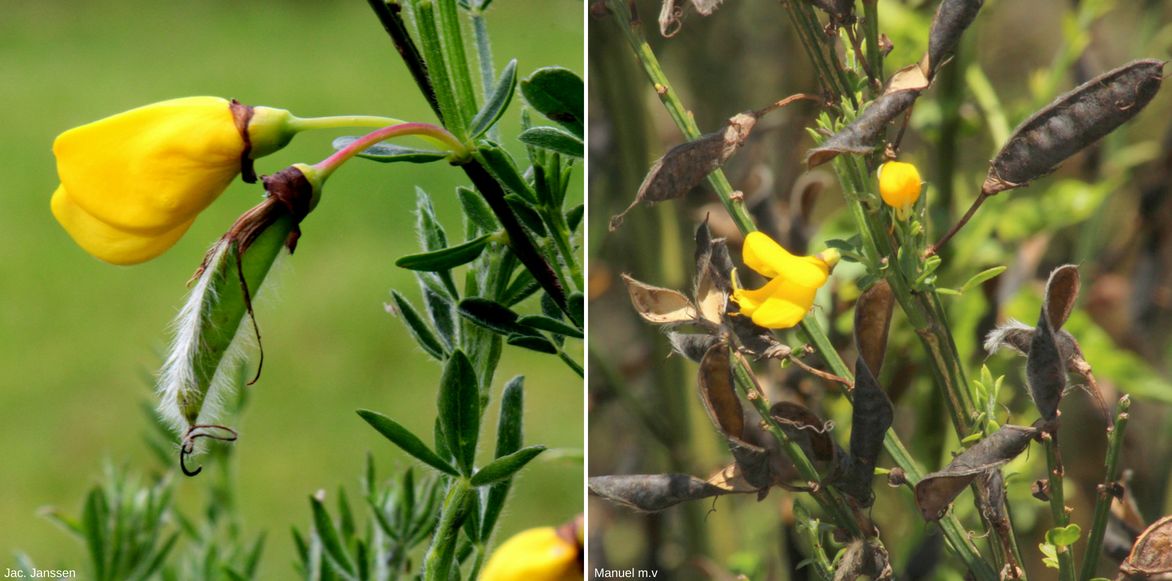 Hairy pods, green then black at maturity.
Hairy pods, green then black at maturity.
In the past, the stripped branches of the broom were used for the making of coarse brooms. It also has many medicinal virtues, primarily diuretic.
Read also
How to prune early flowering bushesMain species and varieties
Today, many varieties, cultivars, and hybrids of Brooms (Cytisus) are available. Most often bright yellow, Brooms now display their flowering in pure white, cream, pink, peach, orange, or purple hues. There are even bicoloured Broom flowers. Flowering occurs in spring for Cytisus, sometimes very early for Cytisus x praecos, and in summer for Genista.
While the most common in our gardens remains the Broom (Cytisus scoparius) with its erect, compact yet light bushy habit, there are also ground-covering varieties like Cytisus decumbens, Cytisus purureus, and Cytisus x kewensis, which are very interesting for rockeries, slopes, or pots.
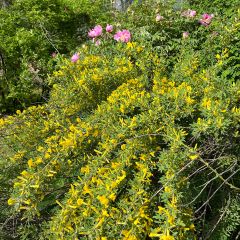
Cytisus praecox Allgold
- Flowering time April, May
- Height at maturity 1,20 m
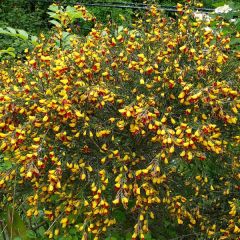
Cytisus scoparius Andreanus
- Flowering time June, July
- Height at maturity 2 m
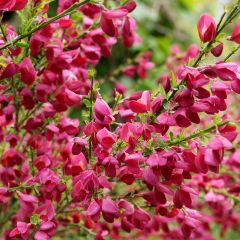
Cytisus scoparius Ruby
- Flowering time June, July
- Height at maturity 1,50 m
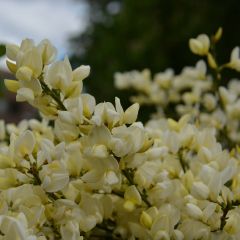
Cytisus x kewensis
- Flowering time June, July
- Height at maturity 50 cm
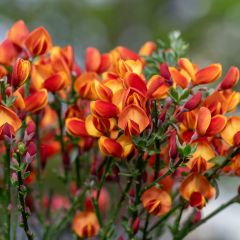
Cytisus scoparius Cytisus Lena
- Flowering time June, July
- Height at maturity 1,30 m
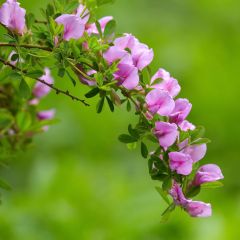
Chamaecytisus purpureus
- Height at maturity 45 cm

Cytisus decumbens
- Flowering time June, July
- Height at maturity 20 cm
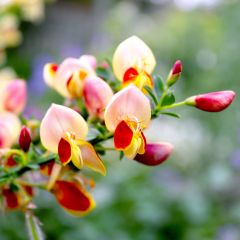
Cytisus scoparius Goldfinch
- Flowering time June, July
- Height at maturity 1,50 m
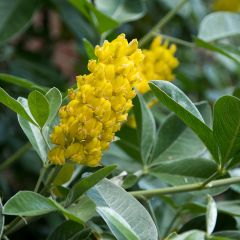
Cytisus battandieri
- Flowering time June to August
- Height at maturity 4 m
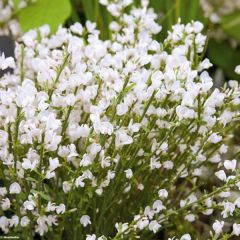
Cytisus praecox Albus
- Flowering time April, May
- Height at maturity 1,20 m

Cytisus scoparius Luna
- Flowering time June, July
- Height at maturity 2 m
Discover other Broom - Cytisus
View all →Available in 4 sizes
Available in 2 sizes
Available in 2 sizes
Available in 1 sizes
Available in 1 sizes
Available in 2 sizes
Available in 1 sizes
Available in 2 sizes
Available in 1 sizes
Available in 1 sizes
Young plantation
Where to plant broom?
Most brooms have an excellent hardiness that allows them to withstand temperatures below -15°C to -20°C in well-drained soil, as winter moisture can harm their hardiness.
Resistant to diseases, frost, and drought, broom is easy to grow in almost all regions. Some species, such as Spanish broom, Spatium junceum, are well adapted to coastal areas. Others, like the dyeing broom, fear the intense droughts of Mediterranean summers. Genistas (Genista lydia) have lower hardiness, preferring mild to warm climates and fearing excessively harsh winters.
Broom should preferably be planted in full sun, even in scorching exposure where it flowers better, although it tolerates light shade. It will only refuse to flower in deep shade.
Not demanding regarding soil type, it grows in almost any situation. A poor, neutral or slightly acidic, light and well-drained soil, even stony, preferably sandy, is sufficient. Most even accept slightly calcareous soils. However, it fears winter moisture, heavy and suffocating soils. Plant it away from freezing drafts and waterlogged soils.
Choose its location carefully as this bush dislikes transplanting; its roots are quite sensitive and delicate. Broom is unobtrusive and adapts to all gardens, bringing a bright and original touch. The genus includes dwarf species for dry, sunny rockeries and larger species.
In any case, since broom tends to spread, provide it with about 1.5 m of space in all directions so it can develop comfortably. Shrubby species will look magnificent at the back of a flowerbed, against a sunny wall, in a hedge, or in a large flowering and fragrant rockery.
Ground-cover varieties not exceeding 70 cm in height will be perfect for covering a rocky slope, a low wall, a very sunny border, or even a container to flower and perfume the surroundings of the house with their sweet scents.
When to plant broom?
Planting brooms is preferably done in autumn, from September to November, to encourage rooting before winter and to have flowering the following spring.
How to plant brooms properly?
In hedges and flowerbeds, depending on the varieties, space the plants about 1.5 m apart. Broom appreciates well-drained soils where water will not stagnate in winter: in heavy, slightly clayey soil, lighten it with turf, pumice, clay balls, or potting soil. In overly calcareous soil, acidify with heather soil.
- Soak the root ball in a basin of water
- Loosen the soil well
- Dig a hole 2 to 3 times wider than the size of the pot
- Make a good drainage layer (pumice, gravel, clay balls) at the bottom of the hole
- Plant the shrub in the centre of the hole
- Backfill and compact the soil around the base of the plant
- Mulch the base with a plant mulch to keep its roots warm during winter
- Water abundantly at planting, then regularly during the first summer, but without allowing water to stagnate at the base of the plant
In pots
Choose compact-growing varieties of broom with moderate growth (Cytisus decumbens, ‘Plena’). The substrate must be very well-drained to avoid stagnant moisture at the roots. Repot every 2 to 3 years.
- At the bottom of a large container of at least 70 cm in diameter, spread a good layer of drainage (gravel or clay balls)
- Plant in a light, neutral or acidic substrate
- Mulch to keep the surface cool
- In summer, water well during flowering, once or twice a week, without drowning the plant
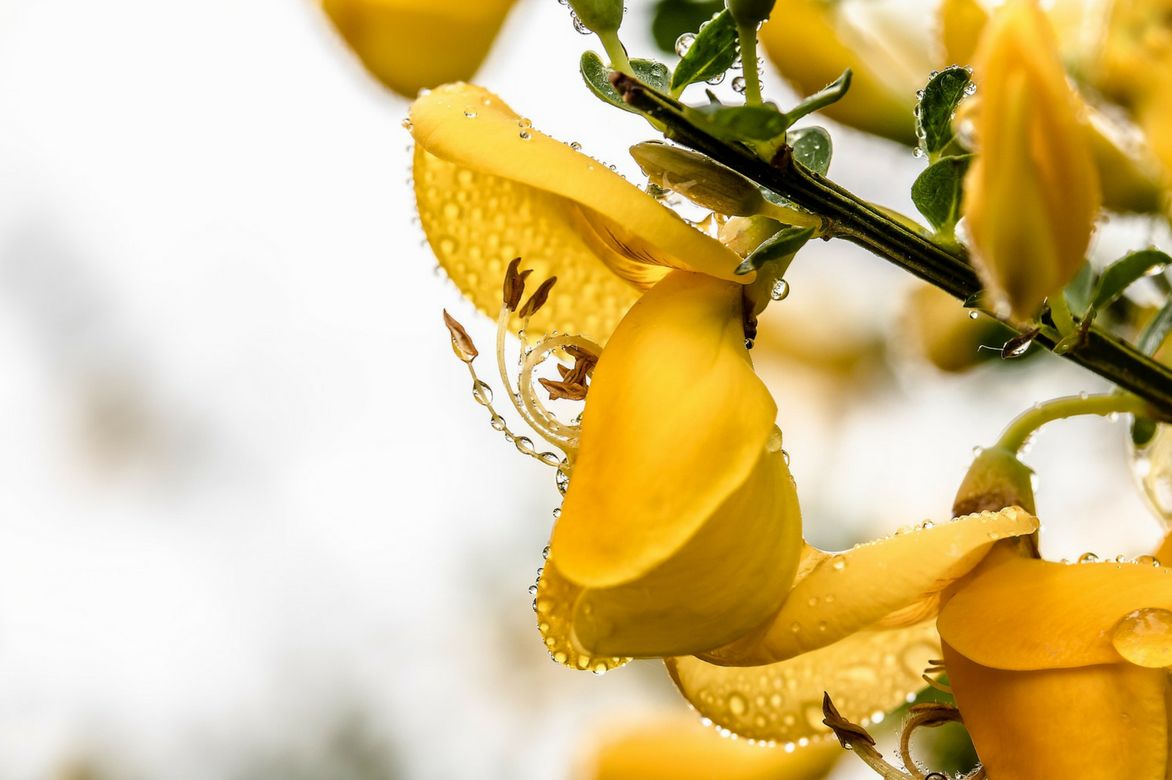
Broom flower under morning dew.
Read also
Pruning of summer-flowering bushesMaintenance, pruning of broom and care
Once established, the Broom requires little maintenance. Some species are more resilient than others: once well-rooted, Spanish Broom is almost indestructible!
It offers a good tolerance to drought and does not require abundant watering except during the first two summers when you should water once or twice a week. After that, only water in case of prolonged heatwaves. To keep the base cool during the warm season, you can refresh the plant mulch in spring, especially in the first few years following planting. Undemanding, in open ground, it does not require fertiliser.
Early, more delicate Brooms can be protected with a winter cover in case of severe frosts.
In pots, water once or twice a week during summer, allowing the substrate to dry completely between waterings. If necessary, repot in autumn every 2-3 years into a slightly larger pot.
Pruning the Broom
Pruning is useful to maintain a compact habit and prevent it from becoming bare with age. It is a shrub with a relatively short lifespan; it will last longer and flower more generously if pruned regularly. Prostrate species require very little pruning.
- Each year after flowering, carry out a refreshing pruning by cutting back the tips of the branches by 15 to 30 cm to prevent fruiting, which exhausts the shrub
- Retain the old lignified wood but remove dead shoots
- In March, large Brooms can be pruned back hard if necessary (for example, if they become deformed under the weight of the crown) to 40 cm from the ground using pruning shears
Diseases and potential pests
The Broom is a bush that shows good resistance to diseases with some precautions during its installation.
While most can tolerate lime, in overly shallow chalky soil, it may show signs of chlorosis, which causes yellowing of the leaves. The broom is particularly sensitive to excess moisture, which can harm its hardiness and cause its roots to rot. To prevent rot, ensure that the soil is sufficiently draining.
It may also be subject to the formation of galls caused by a parasitic mite (phytoptus) that sometimes attacks the tips of the branches. At the beginning of spring, spray repellent decoctions of horsetail. In case of infestation, remove and burn the affected branches.
Multiplication
If brooms are propagated by sowing in March or in autumn with harvested seeds, we recommend propagation by cuttings, the simplest and fastest method. It allows for the renewal of broom plants, which age quickly. The best time is when the plant is in full growth, which is summer for most regions.
By herbaceous cuttings
- In June, take non-flowering, green lateral shoots from the year that are 10 to 15 cm long by simply detaching them to obtain a heel
- Scrape the bark for a few centimetres and remove the lower leaves
- Keep two pairs of upper leaves
- Plant the cuttings in pots or trays in a light, well-draining mix of coarse sand and special cutting compost
- Keep the substrate just moist in partial shade until rooting, which takes 1 to 2 months
- Transplant the cuttings into pots in autumn
- Plant in the ground in spring and water well during the first year
It is also possible to take semi-woody cuttings later in the season, in late summer or early autumn.
→ Learn more with our tutorial: How to take a broom cutting?
Associate
Thanks to its medium dimensions and its dense, upright or spreading silhouette, yet always attractive and airy, the Broom can be used in multiple ways in all natural and wild gardens where it will be a lovely source of light. It will help create colourful and lively spring or summer scenes.
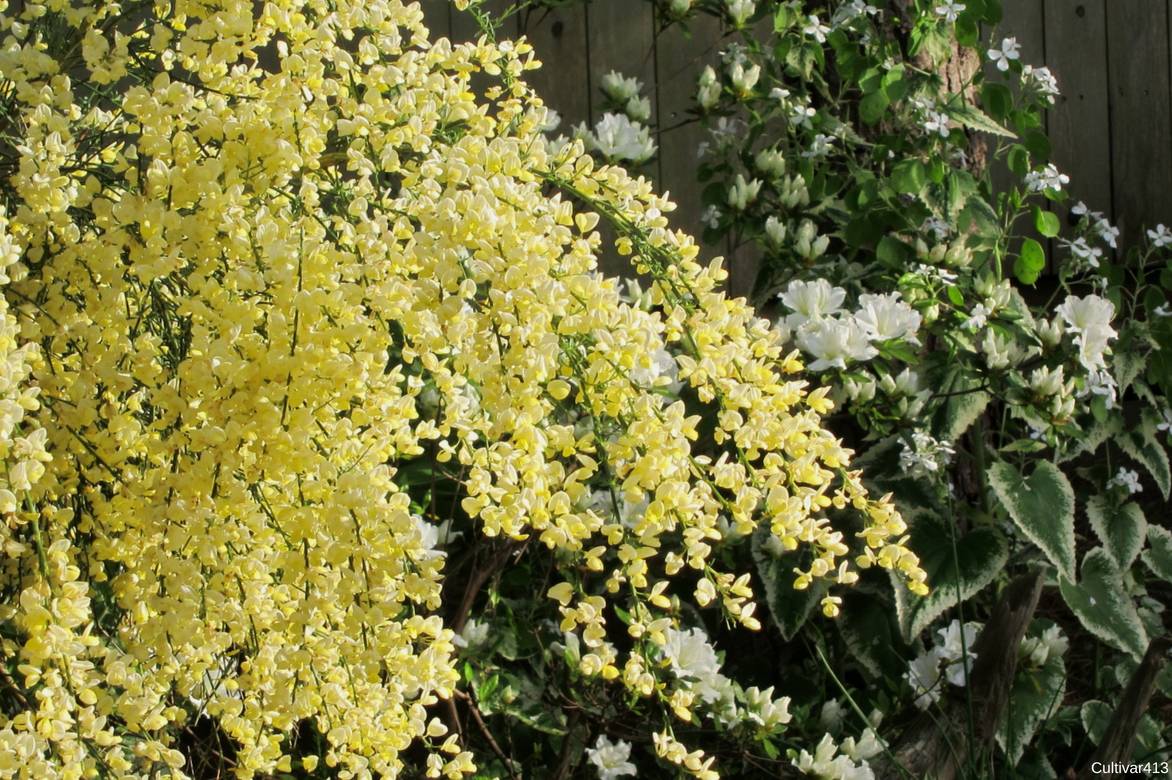
An example of pairing: Cytisus ‘Moonlight’, Azalea such as the variety ‘Palestrina’ for example, Lunaria annua ‘Variegata Alba’.
It will find its place within a flowering hedge, a large shrub bed, or a sunny rockery. It can serve as a focal point in the centre of a small garden or in a pot on a terrace.
Its branches, adorned with a profusion of small flowers most often golden yellow, will stand out powerfully in gold/blue compositions with the blue flowers of aconites and Caucasian forget-me-nots. Varieties with pink, white, or cream flowers pair well with all warm shades like peach or apricot from low-growing helianthemums, potentillas, or benoîtes.
Cytisus praecox can be associated with the late flowers of spring bulbs such as daffodils, tulips, wallflowers, fritillaries, and perennials like spurge.
In a hedge, the light branches of the Broom can be combined with many shrubs with remarkable foliage in purple or with staggered flowering: forsythia, Syringa, ceanothus, buddleias, euonymus, a smokebush, a Prunus. Its branches will stand out well against a backdrop of dwarf conifers.
It will enhance the beauty of a bed alongside a peony and shrubby sages, Erigeron karvinskianus, California poppies, and perennial geraniums for beautiful low-maintenance flowering scenes.
With their diffuse structure, the flowers of the broom highlight plants with more defined shapes like grasses or heathers.

A spring pairing idea: Cytisus praecox ‘Albus’, Brunnera macrophylla ‘Green Gold’, Daffodil ‘Paperwhite’, Daffodil ‘Tête à tête’, and Chionodoxa sardensis.
Pair it with sun-loving shrubs suited to dry, poor soils, such as cistus and strawberry trees with lovely red berries in autumn.
In a garden without irrigation, ground-cover broom varieties will occupy a large slope alongside other unpretentious ground covers like rosemaries or creeping ceanothus.
→ Discover more beautiful ideas for pairing brooms in our advice sheet!
Useful resources
- What to plant in poor, stony soil? Discover our plants resistant to lack of water
- Broom plants are perfect for a low-maintenance garden
- Dare to try contrasting blue/yellow combinations!
- Check out our tutorial: how to prune a broom plant?
- Subscribe!
- Contents
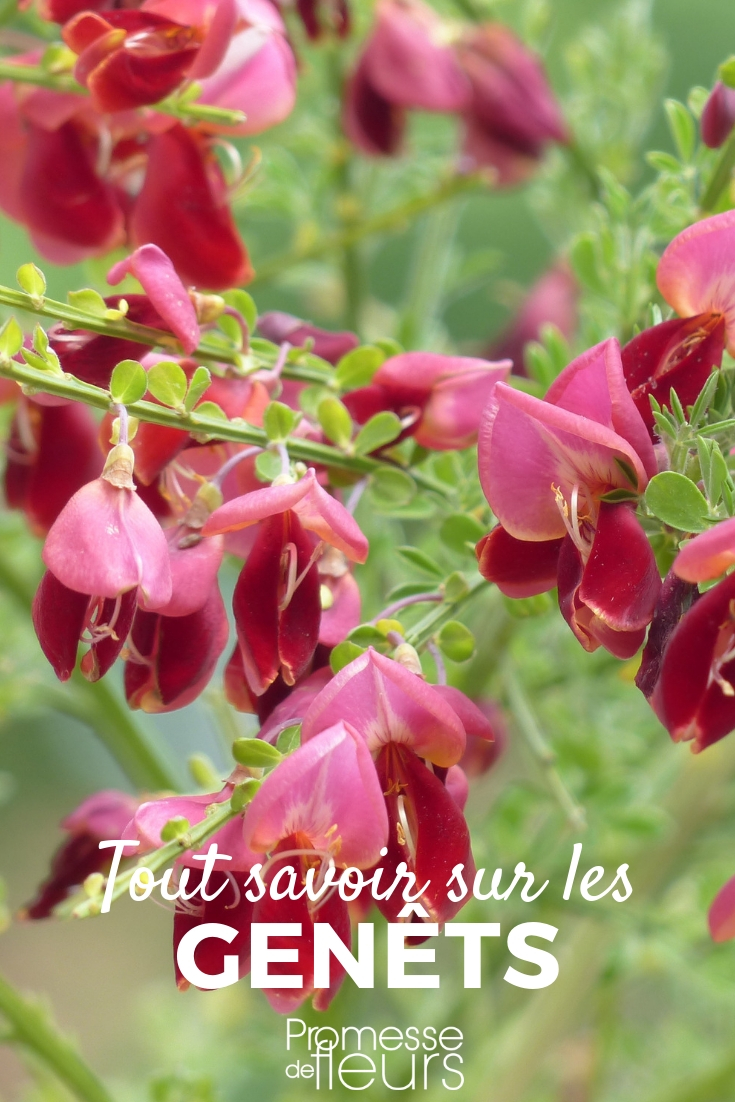































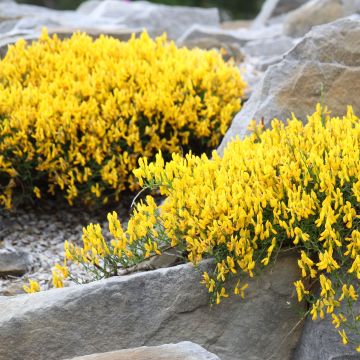

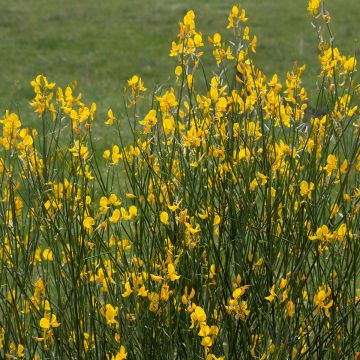







Comments